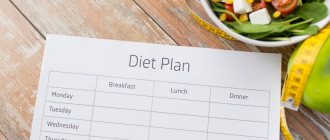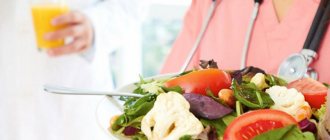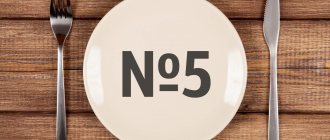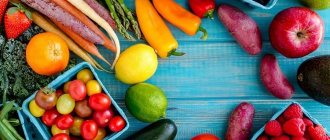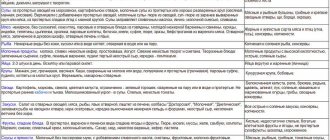Obesity is a rather dangerous condition of the body; it provokes many concomitant diseases. Diet Table No. 8 according to Pevzner will help cope with obesity, and we will talk about its principles and the menu for the week for every day in this article. Reviews of diet 8 from those who have already adhered to this diet indicate that the results are there and pleasantly surprising.
How it works
A positive result when following treatment table 8 is achieved by reducing the calorie content of food, which forces the body to take energy from fat depots. Other principles of this diet:
- The menu is rich in high density lipoproteins . This normalizes and accelerates lipid metabolism.
- The amount of simple carbohydrates is reduced to a minimum . As a result, the level of glucose in the blood is normalized, and there is no sharp decrease in its content during the day. Consequently, there is no spontaneous feeling of hunger and unnecessary snacking.
- The diet 8 table implies frequent meals, but in small portions . Due to this, a reduction in the volume of the stomach is achieved.
This eating regimen prevents overeating. This is also facilitated by the presence of high-fiber foods in the menu.
general characteristics
The goal of the diet is to influence the metabolism to eliminate excess fat deposits.
General characteristics:
reducing the calorie content of the diet due to carbohydrates, especially easily digestible ones, and to a lesser extent fats (mainly animals) with a normal or slightly increased protein content. Restriction of free fluids, sodium chloride and appetite-stimulating foods and dishes. Increased dietary fiber content. Dishes are prepared boiled, stewed, baked. Fried, pureed and chopped products are undesirable. They use sugar substitutes for sweet dishes and drinks (xylitol and sorbitol are taken into account in the calorie content of the diet). The food temperature is normal.
Chemical composition and calorie content:
- carbohydrates - 150 g,
- proteins - 90-110 g (60% animals),
- fats - 80-85 g (30% vegetable),
- calories - 1700-1800 kcal,
- table salt - 5-6 g,
- free liquid - 1-1.2 l.
Diet:
5-6 times a day with enough volume to feel full.
Diet rules: allowed and prohibited foods
General advice, drinking regimen
First of all, it is important to reduce the amount of liquid and salt consumed. Diet at table number 8 implies either complete
eliminating salt from the diet, or its amount should be reduced to 1.5 g per day.
The volume of liquid you drink should not exceed 2 liters daily. It includes liquid meals, drinks, water. The amount of liquid meals should be limited to a bowl of soup at lunch. As for other drinks, these are tea, coffee and milk. Their maximum quantity is 4 glasses per day.
The remaining volume of liquid is water. It should be evenly divided into 3 parts and each part should be drunk 40 minutes before meals.
Diet 8 according to Pevzner is based on the principle of fractional nutrition. The number of meals per day is 5-6. Among them are 3 main meals and 2-3 snacks. Portions should be small; their volume is calculated when creating the menu.
The food itself is prepared by steaming, stewing, and boiling. Frying is also possible, but only using oil with a low fat content. Cooking with fat is prohibited.
Authorized Products
The following products should be excluded from the menu : baked goods made from wheat flour and margarine, dried fruits, bananas, persimmons, grapes, dates, mangoes, soft wheat pasta, fatty meats, high-fat dairy products, legumes, carrots, beets, semolina and oatmeal, rice.
Alcoholic and carbonated drinks, seasonings and other flavor enhancers, and marinades are prohibited.
What's prohibited?
Foods that can be eaten : baked goods made from rye flour or with bran, pasta made from durum wheat, lean meats and fish, sweet and sour fruits and berries, unsweetened vegetables, low-fat dairy products, vegetable soups, olive and flaxseed oils, sugar substitutes (for example, xylitol).
Daily calorie intake is calculated individually and depends on the patient’s lifestyle. Table 8 calories for obesity are usually 1300-1600 per day. With physical activity, this figure increases to 2000-2500 per day.
Features of nutrition for obesity
The principles of Diet 8 for obesity are fully described above. The number of calories consumed and the amount of fluid drunk depend on the severity of the disease. The higher the degree of obesity (there are only 4), the less fluid and calories are allowed. As you lose weight, these indicators are adjusted.
Features of nutrition during pregnancy
The principles of this diet during pregnancy are no different. The difference is that you should limit the volume of fluid consumed to 0.6-0.8 liters per day. In case of edema, this figure may decrease.
Pregnant women should be constantly under the supervision of a doctor, who will adjust the menu if necessary. Sometimes a specialist may prescribe so-called fasting days, during which the daily caloric intake is halved.
For children
Table 8 according to Pevzner is used for weight correction in children. The principles of nutrition are the same as for adults. The difference is that the amount of food consumed should be reduced by 20%. The last meal is 3 hours before going to bed.
List of prohibited ingredients
In order to keep body weight under control and promote its systematic reduction, it is recommended to completely exclude the following food ingredients from the diet:
- Jam, ice cream, natural honey, jelly, fruit and berry jam;
- Any types of pasta;
- Rich fish and meat broths;
- Rice and semolina;
- Chocolate, cocoa;
- Any types of confectionery products, as well as dishes with added sugar;
- Bakery products made from premium flour;
- Butter and puff pastries;
- High-carbohydrate fruit components such as bananas, grapes, dates, figs and any types of dried fruits;
- Herbs and spices such as grated horseradish root, mustard, vinegar, hot pepper and garlic;
- Fast food;
- Any types of sausages and sausages;
- Products subjected to smoking, pickling and salting;
- Any types of dairy and fermented milk products containing more than 15% fat;
- Carbonated and alcoholic drinks;
- Fried chicken and quail eggs;
- Store-bought semi-finished products and any types of canned food.
Indications and contraindications for table No. 8
Diet 8 is intended for obese patients.
This diet is recommended in the absence of serious physical and intellectual stress, otherwise a person will feel increased weakness and fatigue. These factors will negatively affect the patient's daily activities. The diet is thus adjusted in case of overeating (in the absence of pathological conditions, but a high level of stress and low physical activity), as well as lipid metabolism disorders.
Contraindications:
- pathologies of the cardiovascular system;
- renal and liver failure;
- diseases of the digestive tract, primarily those accompanied by malabsorption.
These pathologies require a different diet; diet number 8 may not only not help, but also harm the body.
Reviews and tips for losing weight
My daughter followed the diet. She followed all the doctor’s recommendations, and as a result, she lost 20 kg in six months. Everyone is completely satisfied with the result - our daughter and our family.
Svetlana, 39
Following the table menu 8 according to Pevzner, I lost almost 30 kg in 8 months. Cholesterol and glucose levels also decreased. I feel much healthier than before.
Ekaterina, 44
I have been following Diet 8 for several months now. In this diet, I like balance; the body gets everything it needs. I effectively lost weight and at the same time improved my health, and my blood pressure surges disappeared.
Alexey, 31
The most important advice is a preliminary consultation with a doctor. If you are obese, you cannot start following diet number 8 on your own. The doctor will conduct the necessary tests, assess the patient’s health status, and determine whether there are any concomitant diseases.
Based on these data, the advisability of following the diet will be determined. If the result is positive, the specialist will begin creating a menu.
Additions to diet number 8 (a, b)
This diet was developed using an average method so that it is suitable for the majority of patients with the problem of obesity.
But there are certain types of diet that are used individually, depending on the characteristics of the patient’s body, his physical capabilities and the need to quickly lose weight.
Option A
It is used for the same diseases, but the calorie content of food consumed is further reduced.
With the help of this table, the patient has the opportunity to restore his metabolism in the body and prevent the appearance of new fat cells that are deposited in inappropriate places.
This diet has features:
- It is incomplete, that is, nutrition on it does not meet the body’s needs for certain substances. The amount of fats and carbohydrates is minimized here.
- All products are used with vegetable fats; they are well absorbed by the body without leading to their deposition.
- Enriches the body with dietary fiber and fats of plant origin.
- The amount of incoming liquid is limited - a person should use only 1.5 water in its different states (this is also taken into account in first courses).
- All dishes are prepared without salt - this is the most difficult moment for many patients; food without salt does not bring pleasure from eating it.
- The temperature of food should not exceed 65 degrees.
- In terms of calories, it ranges from 1100 to 1300 kcal.
- The size of the portions eaten is reduced, as well as their calorie content, due to which rapid weight loss occurs.
The principles of preparation are the same as in the generally accepted version. It is important that all products for dishes are cut into large pieces. Why is this being done?
A person is unable to swallow large pieces - this stimulates him to chew thoroughly, which leads to the release of gastric juice.
As a result, a person spends more time chopping food, and the feeling of fullness comes faster.
This diet excludes the use of salt more than 5 mg, it is inferior, it is prescribed for a short period of time. Then the patient is recommended to switch to diet 8 or option 8 B.
Option B
Here the diet is selected with the same features as in the first option. No salt is added, calorie content is further reduced - to 800 kcal.
The patient should forget about eating flour products, fatty meats, marinated, salty foods, pasta, oatmeal, semolina and rice.
When applying this diet, it is recommended to use calcium and iron supplements, since these microelements are supplied with food in critically low quantities. It is also important to take multivitamin complexes.
Detailed menu for the day, week
The menu for diet number 8 is compiled by the doctor together with the patient for each day and week. The selection of products is quite varied. As drinks you can use tomato juice, herbal teas, rosehip decoction, compotes (unsweetened).
Breakfast
Breakfasts for diet number 8 are quite varied. Meals before lunch can be divided into the first (main) and second (snack). Breakfasts for the diet 8 menu can be made up of the following list of products:
- omelet from 1-2 eggs;
- vegetable salad (cabbage, cucumber, beets, tomatoes, peppers);
- the vinaigrette;
- baked jacket potatoes;
- boiled beef tongue;
- vegetable casserole;
- boiled piece of chicken;
- sauerkraut.
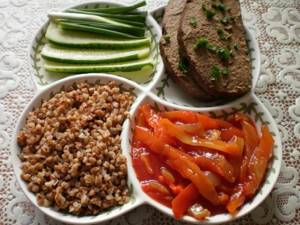
Lunches
Lunch is the main meal of the day, even when on a diet. It necessarily includes vegetable soups (beet soup, okroshka, with buckwheat, different types of borscht, rassolnik). The second course can be represented by stewed meat (beef, rabbit), vegetables, chicken fillet (baked in the oven or grilled), boiled rice (brown), squash or beet caviar.
Dinners
For dinner, eat a piece of boiled or baked fish. Vegetables are added to it (cabbage, zucchini, tomatoes, peppers, boiled potatoes).
You can also eat cottage cheese casserole with a few slices of apple for dinner. After dinner there is a second snack, usually it consists of fermented baked milk, kefir, and yogurt.
Snacks
The following snacks are allowed at table number 8:
- raw and baked apples;
- fresh berries;
- a slice of watermelon or melon;
- low fat cottage cheese;
- fermented baked milk;
- 200 ml kefir;
- oranges;
- grapefruit;
- a small amount of berry jelly.

Weekly menu
The menu for the week is made up of the dishes listed above. In this case, you need to eat 150 g of meat or fish per day (the daily amount of protein). This amount can be divided into 2 or 3 doses.
As for carbohydrates, when dieting on table No. 8, their daily intake is specified. It is no more than 150 g. So-called complex carbohydrates are used in food, which do not cause weight gain.

Diet (table) menu number 8 is an effective way to reduce weight in case of obesity, while at the same time improving the patient’s health indicators. But the preparation of the diet should be done by a specialist and only after examination and analysis of the person.
Features of nutrition for obesity
The menu for each day needs to be balanced by macronutrients, trying to eat protein foods with vegetables at each meal. Animal fats from meat and dairy products will take about 30 g, the rest are vegetable oils in salads or up to 30 g of nuts for a snack. Small meals in the first stages of weight loss help get rid of the haunting feeling of hunger.
People who are overweight often say: “I eat little, but I’m not losing weight.” Although they simply do not realize what they eat in addition to the main food. Starting with porridge and eggs for breakfast, people move on to sausage sandwiches for lunch, liver for snacks and salad for dinner in order to keep themselves in line. Each unaccounted chocolate candy is 100 kcal, each bar is 300 kcal. An enormous amount of bread is consumed with sausage, because you can’t get away with just one piece.
As a result, the process of losing weight comes down to control and thoughtful consumption of food, including keeping a food diary, followed by analyzing the menu and working on mistakes.
The cause of obesity is hidden starvation of the body due to a lack of useful components and an attempt to eat empty calories. As soon as the body receives the correct balance of exercise and movement, the need to constantly “throw wood” into the fire of appetite disappears.

